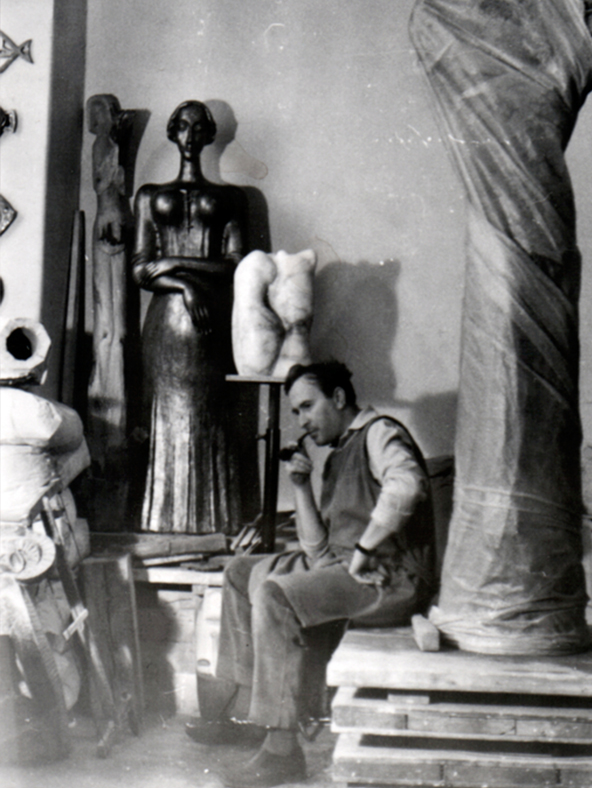Lövith Marc Egon

Cluj-Napoca, 1923 - Cluj-Napoca, 2009
The Life
Marc Egon Lövith grew up with a solid sense of what a united family really meant. He never lost sight of this, even during the hard times of World War II, when the currents of change swept his family away. He managed to channel his pain and shape it into something palpable, something that would enchant the eye of the beholder.
The Art
Lövith had an immense love for sculpting, drawing, painting, and graphic art. One would say he embodies the qualities of a Renaissance artist.
The journey
The story of Marc Egon Lövith starts on the 21st of May, 1923, the day he was born.
The moment he came into this world, he was up against a challenging life, which was meant to transform Marc the boy into Marc the artist, through trials and tribulations. He completed the perfect family picture. That of a modest Jewish family, trying to live a normal, quiet life in Cluj. But the truth was that after the First World War, life for many minorities living in Romania was beginning to crumble. His father, Max Lövith, was about to find that out after his famous watchmaking workshop was vandalized by an extremist gang. This was probably the point in his life when he decided to take his family and move.
In 1926, the Löviths left Romania and emigrated to Mexico, where they lived until 1936, the year of Max's death. Soon after this, Marc returned to Cluj together with his mother and sister. After taking the role of head of the family, the 14-year-old boy was forced to work so he could support their livelihood. It was the pace of the routine which got the boy interested in drawing and painting, unraveling a less pragmatic side of himself which he could not ignore.
Finding love in a wretched place
Unfortunately, his family's life and his own took a terrible turn when in 1944, during the Vienna Dictate, all people of Jewish origin were taken by force to labor camps, including the Löviths. They were taken to a camp in Baia Mare, and later they were transferred to Baja and Törökbalint. Soon after, they were deported to Bavaria, to the Türkheim and Dachau extermination camps. The only survivor of this tragic experience was the artist himself.
Following the Nazi defeat in April 1945, Egon Marc Lövith left the "place of horror" in Dachau, returning to Cluj in the same year together with his wife, Margo Beuer, a young woman from Debrecen, whom he met in the camp. His incarceration was an experience which marked the rest of his life and his art.
Pain, the great motivator
Returned and settled to his new life in Cluj, he attended the art courses of the Union of Artists, Writers and Musicians (1947-1948) and the Ion Andreescu Institute of Fine Arts in Cluj (1953), specializing in sculpture, with Romul Ladea and Ion Irimescu as his teachers. He became an assistant at the Ion Andreescu Institute of Fine Arts in Cluj, in 1962 lecturer, and in 1972 a sculpture professor, later holding the position of head of the department.
His wife Margot was the greatest joy and the biggest influence in Marc Egon Lövith's life. He loved her beyond measure. She was his muse and source of inspiration. Because they were unable to have children, the pair became inseparable. Their company was enough to get them through anything, including the difficulties of life which appeared soon after in communist Romania. However, Lövith never had to resort to creating political art, and the liberalization of the 1970s found him more than ready to break away from socialist art and fully embrace modernism.
That is why his sculptures from the 60s and 70s, remained a turning point in Romanian art and are extremely appreciated for their form and not necessarily for their story. Lövith spoke of the “simplification” of form, as he called it, which found its origins in ancient art (from the Egyptians and Greeks), and which he used precisely to capture only what interested him: beauty and aesthetics. Hand in hand with the simplification of form came the lack of "literature" in his art. Lövith did not try, nor did he want to tell a story. He moved as far away from the description as possible and tried to express a single moment or feeling. A good example is his work „Icarus”, whose story he did not tell, but which he transposed in the moment of failure, of decomposition, without capturing the whole fusion of actions and emotions, before the boy's fall from the sky.
Faithful to his beliefs
The artist also addressed many religious themes in his painting, namely from the Old Testament (the Tree cycle), subjects that are related to his belonging to the Jewish people, a membership he never denied. However, he confessed that he discovered the Bible as a history sheet rather than as a book of devotion. The distance from religion and a savior God is very easy to understand from his point of view, and most of the topics approached have an interpretation.
Marc Egon Lövith was a complex artist, almost like a Renaissance one. He was versatile, able to sculpt, paint, draw, and shape pottery. Sometimes he spoke with regret about the aspects of culture that he did not manage or failed to address, like literature, music, and acting. He managed to channel his traumas and forced himself to create what he considered to be essentially beautiful. The art legacy he left behind was not only diverse and appreciated for its form and concept, but was also very personal.
Establishing himself
In addition to sculpture, he also practiced painting and graphics. In 1995 he donated several sculptures and paintings to the Art Museum in Cluj. He has works exhibited in the museum and state collections in the country, Hungary, Israel, and in private collections in Romania, Germany, Hungary, Israel, Italy, Austria, Switzerland, America, and Canada. Among the most famous sculptures and cycles, we can mention Self-portraits, Golda Mira, Eternal Pair, Holocaust series, Trees, Sombreros Quijotesco, Bagatelles, Mediterranean series, Birds, Spiritual Traces, Sphinx, Nike, and among the art monumental, the Napoca Hotel Complex (Cluj-Napoca) and the Metallurgical Plant from Campia Turzii.
He was a member of the Union of Visual Artists in Romania (1954). He received the Grand Prize (for Opera Omnia) of the Jewish Community of Romania on November 7, 2002.
The famous sculptor, painter and graphic artist passed away on August 31, 2009, at the age of 86 years. His earthly absence is compensated by his presence in the history of Transylvanian and universal art.





